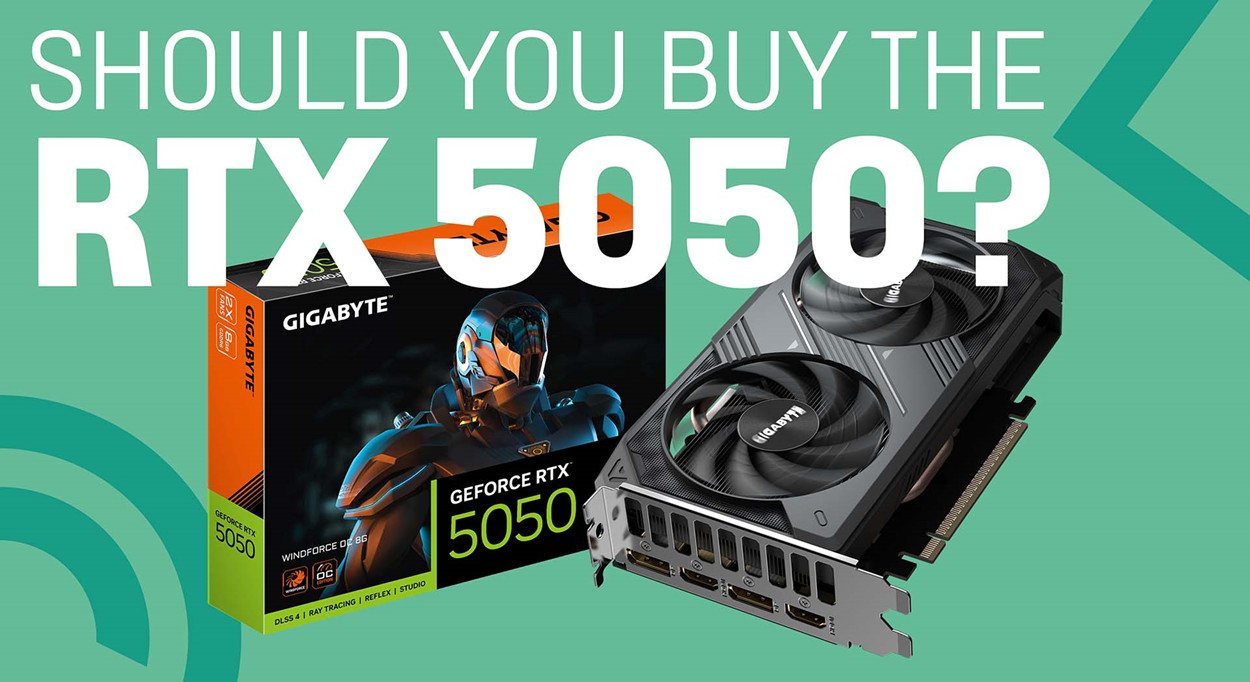
Introduction
NVIDIA’s GeForce RTX 5050 is the company’s newest entry-level GPU based on the latest Blackwell architecture,. It’s a budget-friendly card packed with modern features like DLSS 4 (Deep Learning Super Sampling 4) and real-time ray tracing, along with 8GB of GDDR6 memory and improved power efficiency over previous generations. In simpler terms, the RTX 5050 brings many of NVIDIA’s newest graphics technologies – AI-enhanced upscaling, ray-traced lighting effects, etc. – to a more affordable card that doesn’t guzzle electricity or run too hot. The goal of this post is to help you figure out if the RTX 5050 is the right choice for your needs or if you’d be better off with a different option. Whether you’re a gamer on a budget or building a gaming PC, we’ll break down what the RTX 5050 offers, and who should buy it or skip it.
RTX 5050 Overview
Despite its entry-level positioning, the RTX 5050’s core specs are quite solid. Under the hood it packs 2,560 CUDA cores and 8 GB of video memory (VRAM), with a power draw of about 130 W. In NVIDIA’s performance hierarchy, the RTX 5050 slots in roughly between the older RTX 3050 and the mid-range RTX 4060 cards. In fact, in traditional rasterized (non-ray-traced) graphics performance it’s significantly faster than the old RTX 3050 (over 50% higher in many games) yet still a bit slower than the RTX 4060 in most tests. This means it can handle modern games at decent settings, but it’s not aiming to outshine the higher-tier 60-class GPUs.
One of the standout features of the RTX 5050 is support for DLSS 4 with Multi-Frame Generation. DLSS is NVIDIA’s AI-powered upscaling technology – it can render games at a lower resolution internally and then use AI to super-sample (sharpen and upscale) the image, boosting frame rates without a huge loss in visual quality. The new DLSS 4 takes it a step further by generating additional interpolated frames using AI (that’s the “Multi-Frame Generation” part), which can dramatically smooth out your gameplay. We’ll talk more about DLSS 4 in a bit, but it’s a key upgrade that the RTX 5050 has over older cards.
Considering its specs and features, what is the RTX 5050 ideal for? In short, this card is built for comfortable 1080p gaming (Full HD resolution). It’s a great option if you primarily play games on a standard 1920×1080 monitor. It’s also well-suited for small form factor builds and lower-power systems – with only ~130W TDP, it doesn’t require a massive power supply or elaborate cooling. Many RTX 5050 models are compact in size, making them easy to fit into mini-PC cases. To summarise, the RTX 5050 is designed for:
- Smooth 1080p Gameplay: Capable of high settings in modern titles at Full HD.
- Energy Efficiency: ~130W power draw means less heat and noise, and it’s easier on your electricity bill.
- Compact Builds: Shorter, dual-slot card designs that can fit in smaller PC cases and tight spaces without issue.
Real-World Performance: Game Benchmarks
Specs are one thing—but what most people really want to know is: how many frames per second (FPS) will I get in my games? That’s where the RTX 5050 really proves its value. We tested the card across a range of popular titles at 1080p resolution, using a mix of high-end settings with and without features like DLSS and ray tracing.
Here’s what we found:
| Game |
Settings |
Average FPS |
| Valorant |
1080p, High |
338 fps |
| CS:GO 2 |
1080p, Medium, FSR Off |
223 fps |
| Apex Legends |
1080p, Low |
233 fps |
| Fortnite |
1080p, Medium, DLSS: Quality, RT: Off |
174 fps |
| Call of Duty: Black Ops 6 |
1080p, Ultra, DLSS: Quality, Frame Gen: 1x |
125 fps |
| Hogwarts Legacy |
1080p, Ultra, Ray Tracing: Ultra, DLSS: Quality, Frame Gen: 4x |
121 fps |
| Cyberpunk 2077 |
1080p, RT Overdrive Preset, DLSS: Quality, Frame Gen: 4x |
108 fps |
| Alan Wake 2 |
1080p, High, Ray Tracing: Ultra, DLSS: Quality, Frame Gen: 4x |
108 fps |
| Black Myth: Wukong |
1080p, Very High, Ray Tracing: Very High, DLSS: Quality, Frame Gen: 4x |
96 fps |
| GTA V (Enhanced Edition) |
1080p, Max Ray Tracing Preset, DLSS: Quality |
95 fps |
| Red Dead Redemption 2 |
1080p, Favor Quality Preset, DLSS: Quality |
87 fps |
| Assassin’s Creed Shadows |
1080p, Ultra High, Ray Tracing: Full, DLSS: Quality, Frame Gen: On |
61 fps |
| Elden Ring |
1080p, Max Settings, Ray Tracing: Maximum |
60 fps |
Note: These tests used DLSS in Quality mode where supported. Games with DLSS Frame Generation enabled benefited from smoother frame pacing and higher average FPS.
What These Results Mean
The RTX 5050 performs extremely well at 1080p, even in the latest AAA titles. With features like DLSS 4 and Frame Generation, the card punches well above what you'd expect from a budget GPU.
- In competitive esports titles like Valorant, CS2, and Fortnite, the 5050 delivers well over 100 fps—even above 300 fps in some cases—ideal for high refresh rate monitors and smooth gameplay.
- In graphically intensive AAA games like Cyberpunk 2077, Alan Wake 2, and Assassin’s Creed Shadows, the RTX 5050 is still capable of pushing 60–120 fps thanks to DLSS and frame generation, even with ray tracing turned on.
DLSS 4: A Key Advantage
These high frame rates are largely possible because of DLSS 4, NVIDIA’s latest AI-powered upscaling and frame generation technology. In supported games, it not only improves visual clarity but also boosts frame rates by generating additional frames between the ones your GPU renders. This lets you enjoy smooth, high-FPS gameplay even in very demanding titles.
For example:
- In Cyberpunk 2077, enabling DLSS 4 with frame generation turned on pushed the average FPS from the 60s into the triple digits.
- In Hogwarts Legacy and Alan Wake 2, we saw consistent frame rates above 100 FPS with ray tracing at ultra.
The Trade-Off: Input Lag in Competitive Play
DLSS 4’s frame generation is a game-changer for visuals and smoothness, but it does come with a small trade-off: input latency. That’s the slight delay between pressing a button and seeing it happen on screen.
- In single-player or cinematic games, this is usually unnoticeable and well worth the frame rate boost.
- In fast-paced competitive shooters like Valorant or CS2, some players may prefer to disable frame generation to maintain the most responsive experience. That said, these games already run at extremely high FPS on the RTX 5050 without it.
Who Should Buy the RTX 5050
So, who stands to benefit the most from picking up an RTX 5050? This graphics card is an excellent choice for a range of buyers:
Gamers Upgrading from Older GPUs (GTX 10-Series, GTX 16-Series, or Early RTX 20-Series):
If your PC is running a card like a GTX 1060, GTX 1660, or even an RTX 2060, the RTX 5050 will be a major upgrade in performance, efficiency, and features. You’ll not only see higher FPS in games (potentially double the performance or more compared to a GTX 1060), but you’ll also gain access to new technologies your old card lacks – such as real-time ray tracing effects and DLSS AI upscaling. The difference in visual fidelity and smoothness will be immediately noticeable when you install the 5050. Plus, the RTX 5050’s improved power efficiency means it likely uses less power than some older cards while delivering much more performance, so it runs cooler and quieter too.
Budget 1080p Gamers:
If you’re building or upgrading a PC on a tighter budget and your goal is solid 1080p gaming, the RTX 5050 is squarely aimed at you. It’s one of the most affordable current-generation GPUs and can handle both casual and AAA games at Full HD resolution with very respectable settings. Games like Elden Ring or Marvel’s Spider-Man will run smoothly on this card at high settings 1080p. And for popular free-to-play titles or kids’ games like Minecraft or Roblox, the RTX 5050 is complete overkill (which just means you’ll have no problem running those effortlessly). In short, for gamers who don’t need ultra-high resolution or 240 FPS competitive performance, this card offers a great bang for your buck.
Small-Form-Factor and Low-Power PC Builds:
Not everyone has a giant tower case or a hefty power supply in their PC. The RTX 5050 is a great fit for compact or pre-built systems that might have limited space and power. Many RTX 5050 cards (including some we sell at CCL) are physically compact, even single-fan or dual-fan designs that can fit into Mini-ITX or small Micro-ATX cases. With a typical 130W power requirement, the 5050 doesn’t need an expensive PSU either – a quality 500W or 550W unit is more than enough. If you’re building a PC for your child and using a smaller case, or upgrading a store-bought desktop that has a modest power supply, the RTX 5050 can often drop right in without needing other upgrades. It’s a plug-and-play performance boost for smaller rigs.
Who Should Skip the RTX 5050
While the RTX 5050 is a fantastic budget card, it isn’t the right choice for everyone. Here are a few cases where you might hold off or look for a different GPU instead:
Owners of an RTX 3060, RTX 4060 (or similar performance GPU):
If you already have a mid-tier card from the last generation or two – for example, NVIDIA’s RTX 3060 or RTX 4060 – the RTX 5050 will not offer a meaningful performance upgrade. In fact, the RTX 5050 performs on par with or a bit slower than those GPUs in many games. Upgrading from a 3060/4060 to a 5050 could actually reduce your frame rates in some cases, which makes little sense. So, if you’re already gaming comfortably at 1080p on a 30-series or 40-series card, it’s better to stick with what you have (or consider a higher-tier upgrade like a 5060 or above if you need a real boost).
Gamers Who Play at 1440p, 4K, or Use Very High Texture Mods:
The RTX 5050’s 8GB VRAM (video memory) is sufficient for 1080p, but it can become a limitation at higher resolutions or in extremely demanding titles. If you plan to game at 1440p (QHD) or 4K, or you like to mod your games with ultra high-resolution textures, an 8GB card might run into memory constraints. Newer games are starting to use more than 8GB of VRAM when you push settings to the max at higher resolutions, which can lead to stutters or lower performance on the 5050. In these cases, you’d be better served by a card with more VRAM or just more horsepower in general. Essentially, the RTX 5050 is a 1080p card – if your target is beyond 1080p, you should skip it for a more capable model.
Those Who Can Spend a Bit More for a Big Jump in Performance:
The RTX 5050 is priced attractively, but for roughly £50–100 more you can get cards that significantly outperform it. We’ll detail some alternatives in the next section, but keep in mind that the GPU market has options like AMD’s RX 9060 XT or NVIDIA’s own RTX 5060 which offer a lot more power for not a lot more money. If your budget isn’t extremely tight, it might be wise to invest a little extra upfront for a card that will last longer and handle future games better. In other words, don’t buy the 5050 now and then regret not getting the faster card six months later when a new game pushes it to its limits.
Competitive eSports Players Concerned About Latency:
As mentioned earlier, the RTX 5050’s marquee feature (DLSS 4 frame generation) can introduce some input lag. If you’re a competitive gamer who plays titles like CS:GO, Valorant, or Call of Duty: Warzone and you strive for the lowest possible input latency, relying on frame generation isn’t ideal. Yes, the RTX 5050 can run esports games very fast on its own, but if you were hoping to use DLSS 4 to get ridiculously high frame rates, know that you probably won’t want that feature on in serious competitive play due to the slight delay it can add to your controls. In this scenario, you might prefer a more powerful card that achieves high FPS natively (without needing frame gen). Or if you already have a card that gives you 200+ FPS in your favourite competitive game, there’s no reason to switch to a 5050. In short, hardcore competitive players may want to skip the 5050 or at least not make DLSS 4 a deciding factor.
RTX 5050 Models We Offer
At CCL, we carry a selection of RTX 5050 cards from trusted brands, so you can pick the model that best suits your build. All RTX 5050s perform almost identically in terms of game performance (since they share the same core GPU chip), but they can differ in cooling designs, clock speeds, and size. Here are a few RTX 5050 models we offer (with their current prices as of writing) and what makes each one appealing:
Gigabyte GeForce RTX 5050 GAMING OC 8GB GDDR6
This is a higher-end variant with a robust triple-fan cooling solution and a slight factory overclock for extra performance out of the box. It runs cool and quiet, even under load, thanks to Gigabyte’s Windforce 3X cooler. Despite the beefy cooler, it’s still a standard size card that should fit in mid-size cases.







